(衡水万卷)2016届高三英语二轮复习高考周测卷 周测四 Word版含解析
- 格式:doc
- 大小:514.50 KB
- 文档页数:24
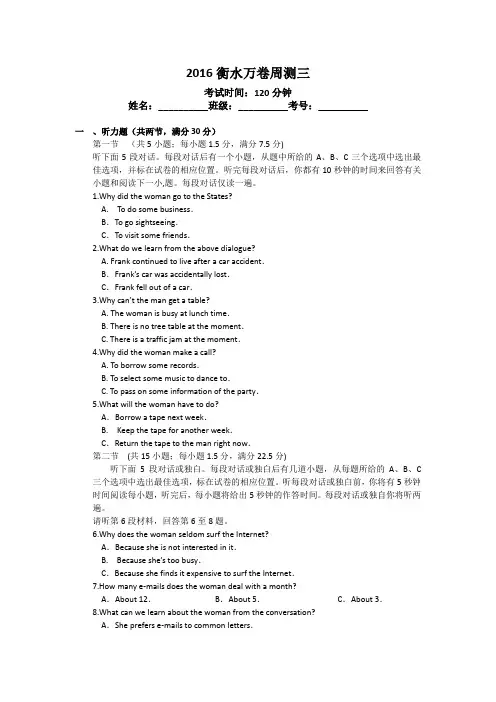
2016衡水万卷周测三考试时间:120分钟姓名:__________班级:__________考号:__________一、听力题(共两节,满分30分)第一节(共5小题;每小题1.5分,满分7.5分)听下面5段对话。
每段对话后有一个小题,从题中所给的A、B、C三个选项中选出最佳选项,并标在试卷的相应位置。
听完每段对话后,你都有10秒钟的时间来回答有关小题和阅读下一小,题。
每段对话仅读一遍。
1.Why did the woman go to the States?A. To do some business.B.To go sightseeing.C.To visit some friends.2.What do we learn from the above dialogue?A. Frank continued to live after a car accident.B.Frank’s car was accidentally los t.C.Frank fell out of a car.3.Why can’t the man get a table?A. The woman is busy at lunch time.B. There is no tree table at the moment.C. There is a traffic jam at the moment.4.Why did the woman make a call?A. To borrow some records.B. To select some music to dance to.C. To pass on some information of the party.5.What will the woman have to do?A.Borrow a tape next week.B. Keep the tape for another week.C.Return the tape to the man right now.第二节(共15小题;每小题1.5分,满分22.5分)听下面5段对话或独白。
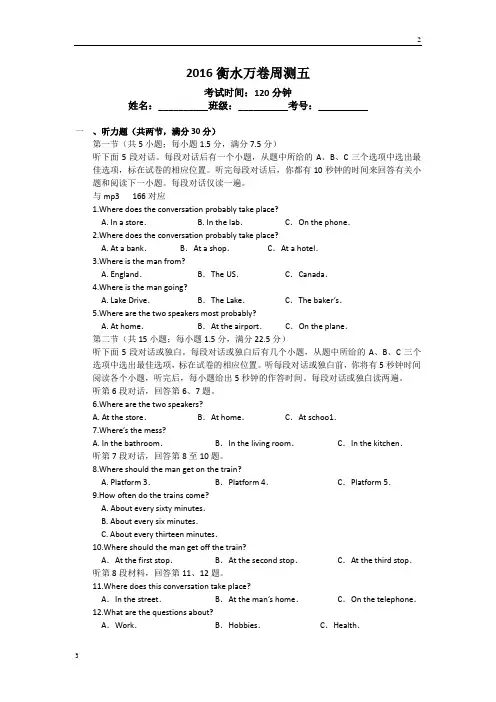
2016衡水万卷周测五考试时间:120分钟姓名:__________班级:__________考号:__________一、听力题(共两节,满分30分)第一节(共5小题;每小题1.5分,满分7.5分)听下面5段对话。
每段对话后有一个小题,从题中所给的A、B、C三个选项中选出最佳选项,标在试卷的相应位置。
听完每段对话后,你都有10秒钟的时间来回答有关小题和阅读下一小题。
每段对话仅读一遍。
与mp3 166对应1.Where does the conversation probably take place?A. In a store.B. In the lab.C.On the phone.2.Where does the conversation probably take place?A. At a bank. B.At a shop.C.At a hotel.3.Where is the man from?A. England.B.The US.C.Canada.4.Where is the man going?A. Lake Drive.B.The Lake.C.The baker’s.5.Where are the two speakers most probably?A. At home.B.At the airport.C.On the plane.第二节(共15小题;每小题1.5分,满分22.5分)听下面5段对话或独白。
每段对话或独白后有几个小题,从题中所给的A、B、C三个选项中选出最佳选项,标在试卷的相应位置。
听每段对话或独白前,你将有5秒钟时间阅读各个小题,听完后,每小题给出5秒钟的作答时间。
每段对话或独白读两遍。
听第6段对话,回答第6、7题。
6.Where are the two speakers?A. At the store.B.At home.C.At schoo1.7.Where’s the mess?A. In the bathroom.B.In the living room.C.In the kitchen.听第7段对话,回答第8至10题。
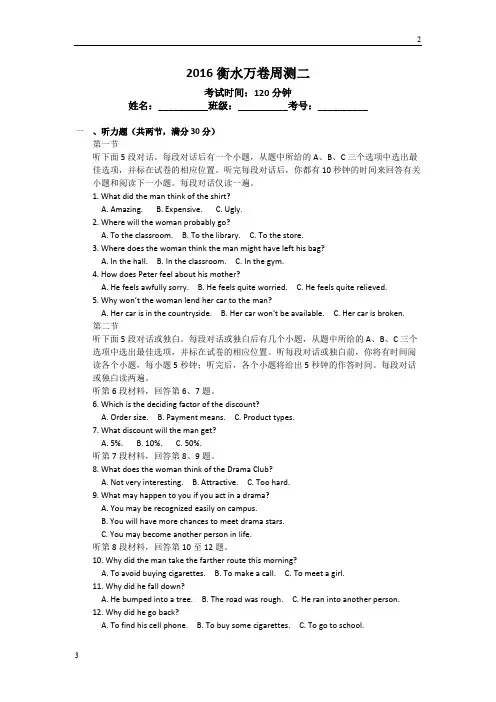
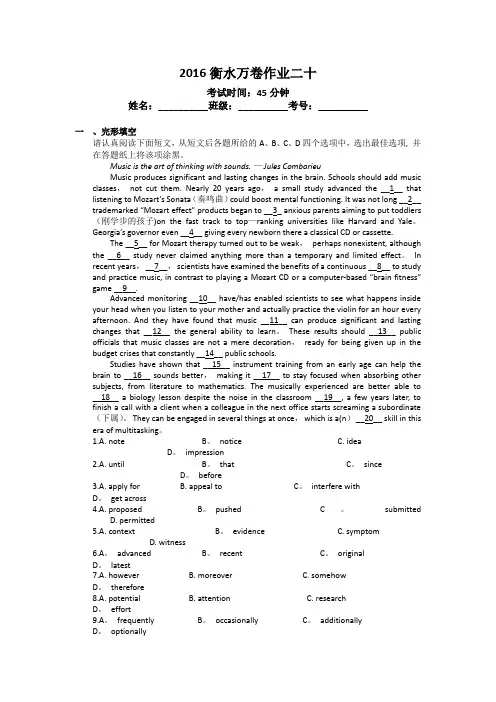
2016衡水万卷作业二十考试时间:45分钟姓名:__________班级:__________考号:__________一、完形填空请认真阅读下面短文,从短文后各题所给的A、B、C、D四个选项中,选出最佳选项, 并在答题纸上将该项涂黑。
Music is the art of thinking with sounds. — Jules CombarieuMusic produces significant and lasting changes in the brain. Schools should add music classes,not cut them. Nearly 20 years ago,a small study advanced the __1__ that listening to Mozart’s Sonata(奏鸣曲)could boost mental functioning. It was not long __2__ trademarked “Mozart effect" products began to __3_ anxious parents aiming to put toddlers (刚学步的孩子)on the fast track to top—ranking universities like Harvard and Yale。
Georgia’s governor even __4__ giving every newborn there a classical CD or cassette.The __5__ for Mozart therapy turned out to be weak,perhaps nonexistent, although the __6__ study never claimed anything more than a temporary and limited effect。
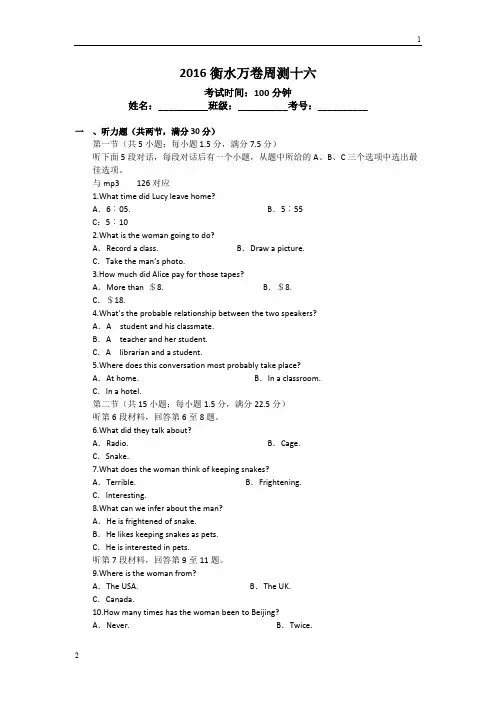
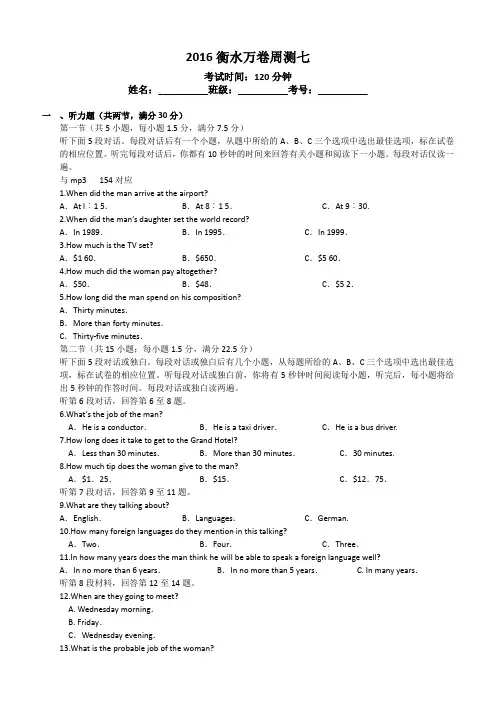
2016衡水万卷周测七考试时间:120分钟姓名:__________班级:__________考号:__________一、听力题(共两节,满分30分)第一节(共5小题,每小题1.5分,满分7.5分)听下面5段对话。
每段对话后有一个小题,从题中所给的A、B、C三个选项中选出最佳选项,标在试卷的相应位置。
听完每段对话后,你都有10秒钟的时间来回答有关小题和阅读下一小题。
每段对话仅读一遍。
与mp3 154对应1.When did the man arrive at the airport?A.At l︰1 5.B.At 8︰1 5.C.At 9︰30.2.When did the man’s daughter set the world record?A.In 1989.B.In 1995.C.In 1999.3.How much is the TV set?A.$1 60.B.$650.C.$5 60.4.How much did the woman pay altogether?A.$50.B.$48.C.$5 2.5.How long did the man spend on his composition?A.Thirty minutes.B.More than forty minutes.C.Thirty-five minutes.第二节(共15小题;每小题1.5分,满分22.5分)听下面5段对话或独白。
每段对话或独白后有几个小题,从每题所给的A、B、C三个选项中选出最佳选项,标在试卷的相应位置。
听每段对话或独白前,你将有5秒钟时间阅读每小题,听完后,每小题将给出5秒钟的作答时间。
每段对话或独白读两遍。
听第6段对话,回答第6至8题。
6.What’s the job of the man?A.He is a conductor.B.He is a taxi driver.C.He is a bus driver.7.How long does it take to get to the Grand Hotel?A.Less than 30 minutes.B.More than 30 minutes.C.30 minutes.8.How much tip does the woman give to the man?A.$1.25.B.$15.C.$12.75.听第7段对话,回答第9至11题。
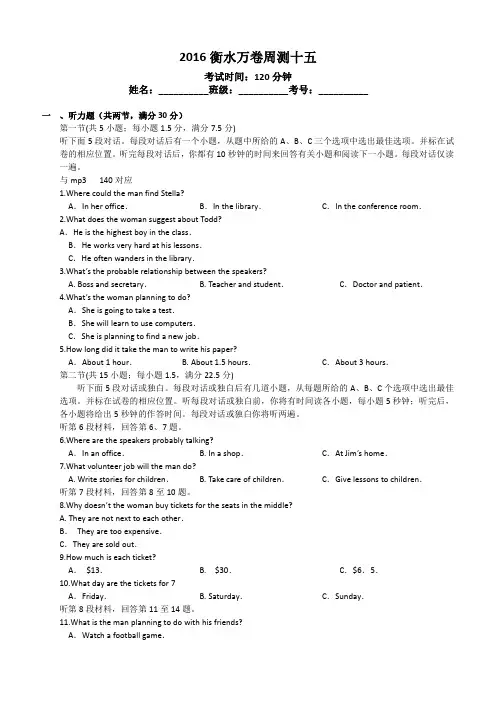
2016衡水万卷周测十五考试时间:120分钟姓名:__________班级:__________考号:__________一、听力题(共两节,满分30分)第一节(共5小题;每小题1.5分,满分7.5分)听下面5段对话。
每段对话后有一个小题,从题中所给的A、B、C三个选项中选出最佳选项。
并标在试卷的相应位置。
听完每段对话后,你都有10秒钟的时间来回答有关小题和阅读下一小题。
每段对话仅读一遍。
与mp3140对应1.Where could the man find Stella?A.In her office.B.In the library.C.In the conference room.2.What does the woman suggest about Todd?A.He is the highest boy in the class.B.He works very hard at his lessons.C.He often wanders in the library.3.What’s the probable relationship between the speakers?A.Boss and secretary.B.Teacher and student.C.Doctor and patient.4.What’s the woman planning to do?A.She is going to take a test.B.She will learn to use computers.C.She is planning to find a new job.5.How long did it take the man to write his paper?A.About1hour. B.About1.5hours.C.About3hours.第二节(共15小题;每小题1.5,满分22.5分)听下面5段对话或独白。
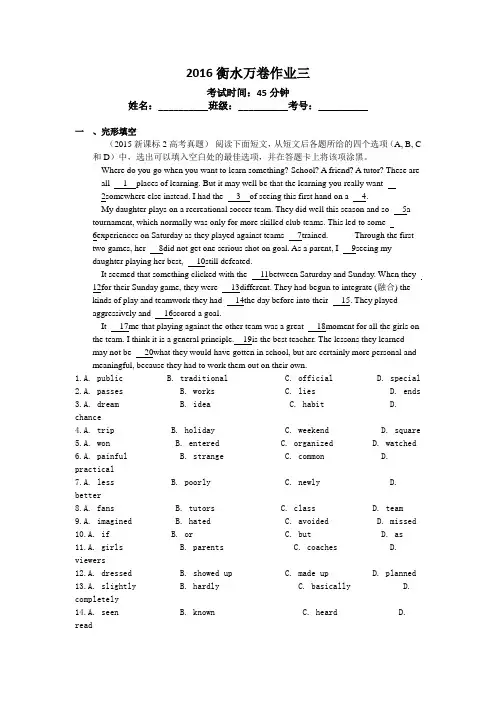
2016衡水万卷作业三考试时间:45分钟姓名:__________班级:__________考号:__________一、完形填空(2015新课标2高考真题)阅读下面短文,从短文后各题所给的四个选项(A, B, C 和D)中,选出可以填入空白处的最佳选项,并在答题卡上将该项涂黑。
Where do you go when you want to learn something? School? A friend? A tutor? These are all 1__places of learning. But it may well be that the learning you really want2somewhere else instead. I had the 3__of seeing this first hand on a 4.My daughter plays on a recreational soccer team. They did well this season and so 5a tournament, which normally was only for more skilled club teams. This led to some6experiences on Saturday as they played against teams 7trained. Through the first two games, her 8did not get one serious shot on goal. As a parent, I 9seeing mydaughter playing her best, 10still defeated.It seemed that something clicked with the 11between Saturday and Sunday. When they 12for their Sunday game, they were 13different. They had begun to integrate (融合) the kinds of play and teamwork they had 14the day before into their 15. They playedaggressively and 16scored a goal.It 17me that playing against the other team was a great 18moment for all the girls on the team. I think it is a general principle. 19is the best teacher. The lessons they learnedmay not be 20what they would have gotten in school, but are certainly more personal and meaningful, because they had to work them out on their own.1.A. public B. traditional C. official D. special2.A. passes B. works C. lies D. ends3.A. dream B. idea C. habit D. chance4.A. trip B. holiday C. weekend D. square5.A. won B. entered C. organized D. watched6.A. painful B. strange C. common D. practical7.A. less B. poorly C. newly D. better8.A. fans B. tutors C. class D. team9.A. imagined B. hated C. avoided D. missed10.A. if B. or C. but D. as11.A. girls B. parents C. coaches D. viewers12.A. dressed B. showed up C. made up D. planned13.A. slightly B. hardly C. basically D. completely14.A. seen B. known C. heard D. read15.A. styles B. training C. game D. rules16.A. even B. still C. seldom D. again17.A. confused B. struck C. reminded D. warned18.A. touching B. thinking C. encouraging D. learning19.A. Experience B. Independence C. Curiosity D. Interest20.A. harmful to B. mixed with C. different from D. applied to二、阅读理解AAs has been all too apparent in recent days at Balcombe, few issues cause greater concern than energy policy. Many village communities feel their countryside is being ruined by the power-producing machines of wind farms; yet they never take "direct action", even though the planning laws put them at a severe disadvantage. And the generous subsidies (财政补贴) , which encourage the expansion of wind power, are not favorable to the village communities and set landowners in conflict with other residents (居民) .Those who disagree with the rapid expansion of wind farms state that the damage they cause is out of proportion(比例) to the benefits they bring, because their energy outputcannot match that of the carbon-based power stations they are supposed to replace.Supporters insist that wind must be part of a mix of renewables, nuclear and carbon, and that the country is committed to meeting EU ( European Union) targets for non-carbonenergy generation.Against this background, the fact that there is an argument within the Government over whether to publish an official report on wind farms' impact on the countryside becomes even more extraordinary. The two parties in the coalition (联合) government are indisagreement over what it should say.We have some advice for the two parties: publish the report, and let the country be the judge. Even if it contains evidence that wind farms are harmful, it will hardly be a pleasant surprise to people who do not like them. Equally, supporters must argue their case byacknowledging the concerns and explaining why they are either misplaced or worthy ofmuch attention.The suggestion that further negotiations are to take place to produce an "acceptable"report suggests that the politics of coalition government are doing the country harm in a certain way. Given the sensitivities involved, all the information should be available so that people can reach their own conclusions, rather than being left with the suspicion(猜疑)that facts are being replaced by political beliefs.21.We can learn from the first paragraph that__________.A. energy policy catches much attention of the publicB. the residents are in favor of the expansion of wind farmsC. many village communities are satisfied with the subsidiesD. the planning laws offer great benefits to the residents22.Supporters think that the expansion of wind power____.A. is more rapid than that of carbon-based powerB. guarantees an increase in energy outputC. is expected to be much better than that of nuclear powerD. agrees with EU targets for non-carbon energy generation23.It can be inferred from the passage that____.A. an official report will settle the energy problemB. the two parties are divided over the issue of wind farmsC. the two parties have agreed on a further negotiationD. political beliefs concerning energy issue go against facts24.Which of the following reflects the author's opinion?A. Increase political impact on energy policy.B. Release a statement of supporters on wind farms.C. Let the nation judge the facts about wind power.D. Leave the two parties to reach their own conclusions.BIt was a cold winter day. A woman drove up to the Rainbow Bridge tollbooth (收费站). “I’m paying for myself, and for the six cars behind me,” she said with a smile, handing over seven tickets. One after another, the next six drivers arriving at the tollbooth were informed, “Some lady up ahead already paid your fare.”It turned out that the woman, Natalie Smith, had read something on a friend’s refrigerator: “Practice random kindness and senseless acts of beauty.” The phrase impressed her so much that she copied it down.Judy Foreman spotted the same phrase on a warehouse wall far away from home. When it stayed in her mind for days, she gave up and drove all the way back to co py it down. “I thought it was beautiful,” she said, explaining why she’d taken to writing it at the bottom of all her letters, “like a message from above.” Her husband, Frank, liked the phrase so much that he put it up on the classroom wall for his students, one of whom was the daughter of Alice Johnson, a local news reporter. Alice put it in the newspaper, admitting that though she liked it, she didn’t know where it came from or what it really meant.Two days later, Alice got a call from Anne Herbert, a woman living in Marin. It was in a restaurant that Anne wrote the phrase down on a piece of paper, after turning it around in her mind for days.“Here’s the idea,” Anne says. “Anything you think there should be more of, do it randomly.” Her fantasies include painting the classrooms of shabby schools, leaving hot meals on kitchen tables in the poor part of town, and giving money secretly to a proud old lady. Anne says, “Kindness can build on itself as much as violence can.”The acts of random kindness spread. If you were one of those drivers who found your fare paid, who knows what you might have been inspired to do for someone else later. Like all great events, kindness begins slowly, with every single act. Let it be yours!25.Why did Natalie Smith pay for the six cars behind her?A. She knew the car drivers well.B. She wanted to show kindness.C. She hoped to please others.D. She had seven tickets.26.Judy Foreman copied down the phrase because she .A. thought it was beautifully writtenB. wanted to know what it really meantC. decided to write it on a warehouse wallD. wanted her husband to put it up in the classroom27.Who came up with the phrase according to the passage?A. Judy Foreman.B. Natalie Smith.C. Alice Johnson.D. Anne Herbert.28.Which of the following statements is closest in the meaning to the underlined sentence above?A. Kindness and violence can change the world.B. Kindness and violence can affect one’s behavior.C. Kindness and violence can reproduce themselves.D. Kindness and violence can shape one’s character.29.What can we infer from the last paragraph?A. People should practice random kindness to those in need.B. People who receive kindness are likely to offer it to others.C. People should practice random kindness to strangers they meet.D. People who receive kindness are likely to pay it back to the giver.CBLOOD DRIVE &MARROW(骨髓)REGISTRATION“These patients deserve a chance at a normal, happy future and they rely on the kindness of the strangers to make that happen.—Daisy, Isabelle’s MotherIsabelle is the daughter of Daisy and Saman Mirzaei. In January 2008 Isabelle was diagnosed (诊断)with a genetic blood disorder,beta thalassemia. Isabelle’s body is unable to producehealthy red blood cells. As a result, Isabelle has been receiving blood transfusions (输血) every 4-6weeks since she was 11 months old. A lifetime of regular transfusions can lead to serious medical problems. Her only chance at a normal, healthy life is to have a marrow transplant. Isabelle is an only child, so doctors have started a search for an unrelated marrow donor through the Be The Match Registry. The Mirzaei family asks that you consider helping patients like Isabelle by registering to be a marrow donor and give the gift of life, the gift of blood.Held at Wiley HallWednesday, March26, 2014Behind Heathman Dormitory/Butterfield Rd.1212:00 PM - 6 :00 PMDon’t forget to bring your driver’s license or another form of identification when you donate.Visit to make an appointment, Sponsor Code 3390.FREE Kingston Pizza ! ! !www. ribc. org 800-283-8385The Rhode Island Blood Center distributes blood products to hospitals in Rhode Island and Southern New England.30.We can learn from the passage that__________.A. the blood drive is organized by Isabelle's motherB. Isabelle receives blood transfusions regularlyC. Isabelle has been ill for 11 monthsD. doctors will sponsor Isabelle's family31.To be a marrow donor, you must_____________.A. be a relative of the patientB. carry a driver's licenseC. be at least 18 years oldD. apply to Michael's Fund32.Those who want to help patients like Isabelle can ___________.A. come to Wiley Hall every WednesdayB. visit www. ribc. org for an appointmentC. contact their parents at 800-283-8385D. call at hospitals in Rhode IslandDThe behaviour of a building’s users may be at least as important as its design when it comes to energy use, according to new research from the UK Energy Research Centre (UKERC). The UK promises to reduce its carbon emissions (排放)by 80 percent by 2050, partof which will be achieved by all new homes being zero-carbon by 2016. But this reportshows that sustainable building design on its own — though extremely important- is not enough to achieve such reductions: the behaviour of the people using the building has to change too.The study suggests that the ways that people use and live in their homes have been largely ignored by existing efforts to improve energy efficiency (效率),which instead focus on architectural and technological developments.‘Technology is going to assist but it is not going to do everything,’explains Katy Janda, aUKERC senior researcher,‘consumption patterns of bui lding users can defeat the mostcareful design. ’In other words,old habits die hard, even in the best-designed eco-home.Another part of the problem is information. Households and bill-payers don’t have the knowledge they need to change their energy-use habits. Without specific information,it’s hard to estimate the costs and benefits of making different choices. Feedback (反馈)facilities, like smart meters and energy monitors,could help bridge this information gap by helping people see how changing their behaviour directly affects their energy use; some studies have shown that households can achieve up to 15 percent energy savings usingsmart meters.Social science research has added a further dimension (方面),suggesting thatindividuals’behaviour in the home c an be personal and cannot be predicted whether people throw open their windows rather than turn down the thermostat (恒温器) , for example.Janda argues that education is the key. She calls for a focused programme to teach people about buildings and their own behaviour in them.33.As to energy use, the new research from UKERC stresses the importance of________.A. zero-carbon homesB. the behaviour of building usersC. sustainable building designD. the reduction of carbon emissions34.The underlined word “which” in Paragraph 2 refers to”________.”A. the waysB. their homesC. developmentsD. existing efforts35.What are Katy Janda’s word s mainly about?A. The importance of changing building users’habits.B. The necessity of making a careful building design.C. The variety of consumption patterns of building users.D. The role of technology in improving energy efficiency.36.The information gap in energy use _______.A. can be bridged by feedback facilitiesB. affects the study on energy monitorsC. brings about problems for smart metersD. will be caused by building users’ old habits37.What does the dimension added by social science research suggest?A. The social science research is to be furthered.B. The education programme is under discussion.C. The behaviour of building users is unpredictable.D. The behaviour preference of building users is similar.三、七选五(2015陕西高考真题)根据短文内容,从下框的A~F选项中选出能概括每一段主题的最佳选项,并在答题卡上将该选项涂黑。
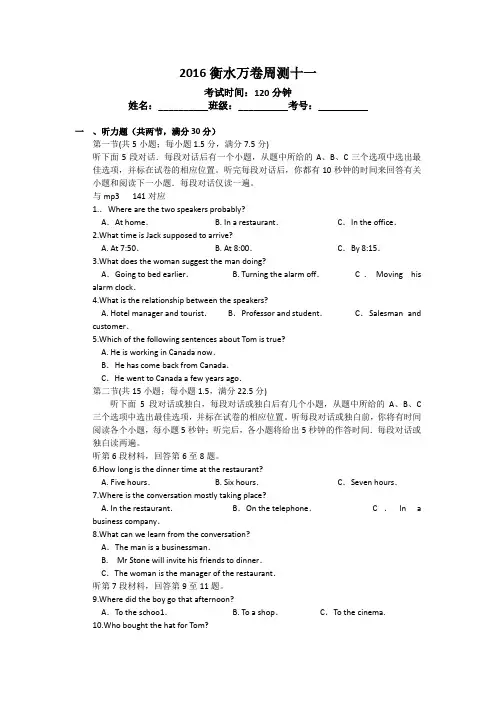
2016衡水万卷周测十一考试时间:120分钟姓名:__________班级:__________考号:__________一、听力题(共两节,满分30分)第一节(共5小题;每小题1.5分,满分7.5分)听下面5段对话.每段对话后有一个小题,从题中所给的A、B、C三个选项中选出最佳选项,并标在试卷的相应位置。
听完每段对话后,你都有10秒钟的时间来回答有关小题和阅读下一小题.每段对话仅读一遍。
与mp3 141对应1..Where are the two speakers probably?A.At home. B. In a restaurant.C.In the office.2.What time is Jack supposed to arrive?A. At 7:50.B. At 8:00.C.By 8:15.3.What does the woman suggest the man doing?A.Going to bed earlier. B. Turning the alarm off.C.Moving his alarm clock.4.What is the relationship between the speakers?A. Hotel manager and tourist.B.Professor and student.C.Salesman andcustomer.5.Which of the following sentences about Tom is true?A. He is working in Canada now.B.He has come back from Canada.C.He went to Canada a few years ago.第二节(共15小题;每小题1.5,满分22.5分)听下面5段对话或独白,每段对话或独白后有几个小题,从题中所给的A、B、C 三个选项中选出最佳选项,并标在试卷的相应位置。
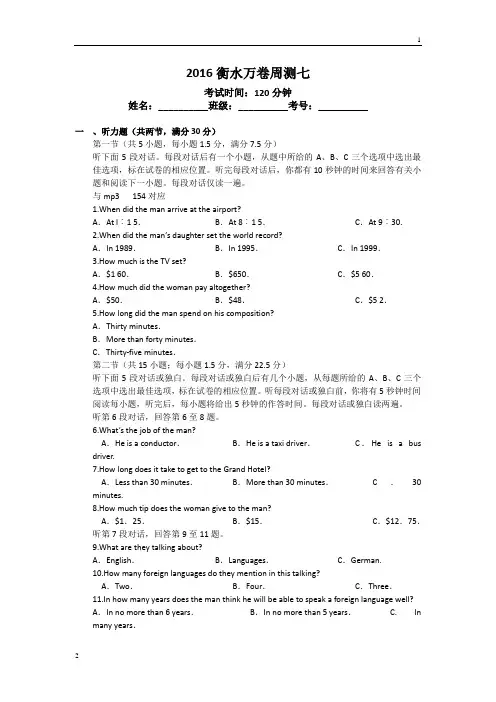
2016衡水万卷周测七考试时间:120分钟姓名:__________班级:__________考号:__________一、听力题(共两节,满分30分)第一节(共5小题,每小题1.5分,满分7.5分)听下面5段对话。
每段对话后有一个小题,从题中所给的A、B、C三个选项中选出最佳选项,标在试卷的相应位置。
听完每段对话后,你都有10秒钟的时间来回答有关小题和阅读下一小题。
每段对话仅读一遍。
与mp3 154对应1.When did the man arrive at the airport?A.At l︰1 5.B.At 8︰1 5.C.At 9︰30.2.When did the man’s daughter set the world record?A.In 1989.B.In 1995.C.In 1999.3.How much is the TV set?A.$1 60.B.$650.C.$5 60.4.How much did the woman pay altogether?A.$50.B.$48.C.$5 2.5.How long did the man spend on his composition?A.Thirty minutes.B.More than forty minutes.C.Thirty-five minutes.第二节(共15小题;每小题1.5分,满分22.5分)听下面5段对话或独白。
每段对话或独白后有几个小题,从每题所给的A、B、C三个选项中选出最佳选项,标在试卷的相应位置。
听每段对话或独白前,你将有5秒钟时间阅读每小题,听完后,每小题将给出5秒钟的作答时间。
每段对话或独白读两遍。
听第6段对话,回答第6至8题。
6.What’s the job of the man?A.He is a conductor.B.He is a taxi driver.C.He is a bus driver.7.How long does it take to get to the Grand Hotel?A.Less than 30 minutes.B.More than 30 minutes.C.30 minutes.8.How much tip does the woman give to the man?A.$1.25.B.$15.C.$12.75.听第7段对话,回答第9至11题。
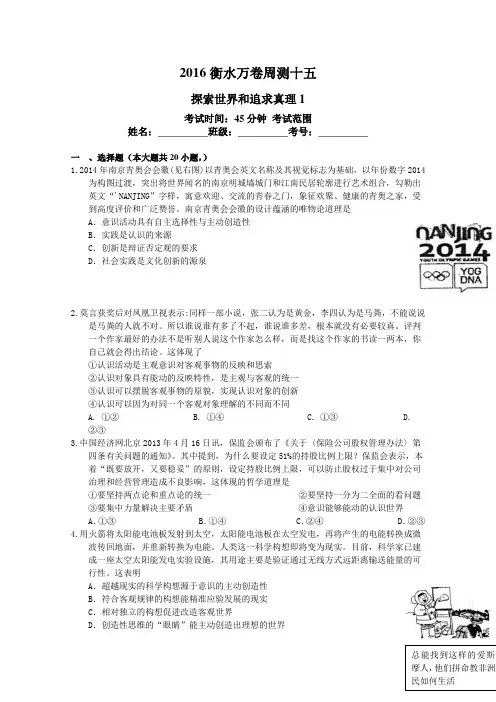
2016衡水万卷周测十五探索世界和追求真理1考试时间:45分钟考试范围姓名:__________班级:__________考号:__________一、选择题(本大题共20小题,)1.2014年南京青奥会会徽(见右图)以青奥会英文名称及其视觉标志为基础,以年份数字2014为构图过渡,突出将世界闻名的南京明城墙城门和江南民居轮廓进行艺术组合,勾勒出英文“'NANJING”字样,寓意欢迎、交流的青春之门,象征欢聚、健康的青奥之家,受到高度评价和广泛赞誉。
南京青奥会会徽的设计蕴涵的唯物论道理是A.意识活动具有自主选择性与主动创造性B.实践是认识的来源C.创新是辩证否定观的要求D.社会实践是文化创新的源泉2.莫言获奖后对凤凰卫视表示:同样一部小说,张二认为是黄金,李四认为是马粪,不能说说是马粪的人就不对。
所以谁说谁有多了不起,谁说谁多差,根本就没有必要较真。
评判一个作家最好的办法不是听别人说这个作家怎么样,而是找这个作家的书读一两本,你自己就会得出结论。
这体现了①认识活动是主观意识对客观事物的反映和思索②认识对象具有能动的反映特性,是主观与客观的统一③认识可以摆脱客观事物的原貌,实现认识对象的创新④认识可以因为对同一个客观对象理解的不同而不同A. ①②B. ①④C. ①③D.②③3.中国经济网北京2013年4月16日讯,保监会颁布了《关于〈保险公司股权管理办法〉第四条有关问题的通知》。
其中提到,为什么要设定51%的持股比例上限?保监会表示,本着“既要放开,又要稳妥”的原则,设定持股比例上限,可以防止股权过于集中对公司治理和经营管理造成不良影响,这体现的哲学道理是①要坚持两点论和重点论的统一②要坚持一分为二全面的看问题③要集中力量解决主要矛盾④意识能够能动的认识世界A.①③ B.①④ C.②④ D.②③4.用火箭将太阳能电池板发射到太空,太阳能电池板在太空发电,再将产生的电能转换成微波传回地面,并重新转换为电能。
1 2016衡水万卷周测四 考试时间:120分钟 姓名:__________班级:__________考号:__________
一 、听力题(共两节,满分30分) 第一节 听下面5段对话。每段对话后有一个小题,从题中所给的A、B、C三个选项中选出最佳选项,并标在试卷的相应位置。听完每段对话后,你都有10秒钟的时间来回答有关小题和阅读下一小题,每段对话仅读一遍。 1.What does the woman love? A. Brown meat. B. White meat. C.She doesn’t mind. 2.How did the man like the beef? A.Delicious. B.Satisfying. C.Not satisfying. 3.How does the woman feel? A.Discouraged. B.Satisfied. C.Happy. 4.What does the woman think of Ann? A.She is too young to be a manager. B. She is able to be a good manager. C.She learns a lot from her father. 5.What does the boy want to be in the future? A.A businessman. B. A lawyer. C.A professor. 第二节 听下面5段对话或独自。每段对话或独白后有几道小题,从每题所给的A、B、C三个选项中选出最佳选项,标在试卷的相应位置。听每段对话或独白前,你将有5秒钟时间阅读每小题,听完后,每小题将给出5秒钟的作答时间。每段对话或独白你将听两两遍。 听第6段材料,回答第6至8题。 6.What’s the man? A.A bus driver. 2
B.A manager in a bus company. C.A reporter. 7.What is the woman’s opinion about the bus service? A.There are too many stops. B.The time-tables are not accepted. C.Buses are often not on time. 8.Why does the woman say her husband is fortunate? A.He often goes to work in a friend’s car. B. He doesn’t need to go shopping by bus. C.He works in a bus station. 听第7段材料,回答第9至11题。 9.How does the man feel? A.Nervous. B.Upset. C.Sick. 10.What’s wrong with the man? A.He had a car accident. B.He was knocked down by a car. C.He had an accident when walking on the street. 11.How did it happen? A.The road-sign had a wrong direction. B.The other driver was driving very fast. C.Something was wrong with the driving mirror. 听第8段材料,回答第l2至14题。 12.How does the man seem to feel after this interview? A.Nervous. B.Hopeful. C.Sad. 13.How many people were NOT chosen for the second interview? A. 4 B.8. C.12. 14.What does the man’s girlfriend want? A.She hopes to find a job near the man. B. She hopes the man finds a job near her. C.She hopes the man gets a job far away from her home. 3
听第9段材料,回答15至17题。 15.Where did Sue spend the nights in the country? A.In a farm house. B.In the open. C.At a hotel. 16.What was the weather like in the country? A. It snowed a lot. B. It rained nearly every day. C. There was a lot of sunshine. 17.What did Sue think of the people in the country? . A. They were tall. B.They were strange. C.They were friendly. 听第10段材料,回答第18至20题。 18.Who is the speaker? A. A policeman. B.David’s neighbor. C.David’s friend. 19.What can you learn from the story? A. The speaker lost the key to the door. B.The speaker forgot to feed the birds. C.David’s neighbor has fed the birds. 20.What do you think of the speaker? A. Honest. B.Careful. C.Humorous.
二 、阅读理解(共两节,满分40分) 第一节(共15小题,每小题2分,满分30分) 阅读下列短文,从每题所给的四个选项(A、B、C和D)中,选出最佳选项 A Deborah Cohen is a senior natural scientist at the Rand Corp and the author of the book A Big Fat Crisis: The Hidden Forces Behind the Obesity Epidemic and How We Can End It. According to the book, there are lots of misunderstandings of obesity. 1.If you’re obese, blame your genes. Obesity rates have increased. Yet, between 1980 and 2000, the number of Americans who are obese has doubled—too quickly for genetic factors to be responsible. At restaurants, a dollar puts more calories on our plates than ever before, because 4
restaurant meals usually have more calories than what we prepare at home, so people who eat out more frequently have higher rates of obesity than those who eat out less. 2.If you’re obese, you lack self-control. Research shows that if we are faced with too much information, we have a tendency to make poor dietary choices. Our world has become so rich in temptation that we can be led to consume too much in ways we can’t understand. Even the most vigilant(警觉的) people may not be up to the task of controlling themselves. 3.Lack of access to fresh fruits and vegetables is responsible for obesity. Although the US Department of Agriculture estimates that fewer than 5 percent of Americans live in the “food deserts”, about 65 percent of the nation’s population is overweight or obese. For most of us, obesity is not related to access to more fresh fruits and vegetables, but to the choices we make in supermarkets. 4.The problem is not that we eat too much, but that we don’t exercise. Michelle Obama’s “Let’s Move” campaign is based on the idea that if kids exercise more, childhood obesity rates will decrease. But there was no significant decrease in physical activity levels as obesity rates climbed in the 1980s and 1990s. In fact, although a drop in work-related physical activity may account for up to 100 fewer calories burned, leisure physical activity appears to have increased. The problem is that we eat too much. 21.The author mentioned Deborah Cohen’s book in Paragraph 1 to _______. A. introduce the topic B. draw readers’ attention C. introduce the author of the book D. advertise the book 22.What is the relationship between obesity and the place where you eat? A. The less you eat out, the higher rates of obesity you have. B. The less you eat at home, the lower rates of obesity you have. C. The more you eat out, the higher rates of obesity you have. D. The more you eat at home, the higher rates of obesity you have. 23.What’s the best title of this passage? A. Four misunderstandings of obesity. B. Four rules to help you avoid obesity. C. Obesity leads to a big fat crisis. D. Lacking self-control leads to obesity.